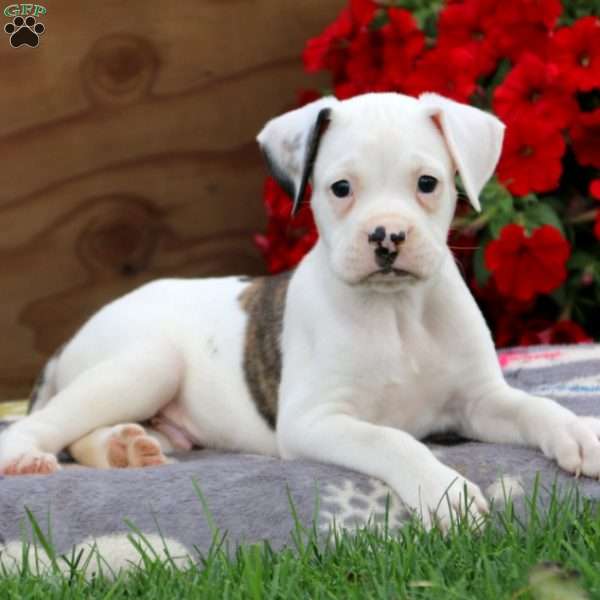
-
Activity Level:
high
-
Shedding Level:
low
-
Grooming Level:
low
-
Trainability:
moderate
-
Good for Novice Owners:
moderate
-
Adaptability:
moderate
-
Kid/Pet Friendly:
often
-
Prey Drive:
high
-
Watchdog:
aware
- Average Size: Medium
- Average Lifespan: 10-14 years
- Registered?: other
Valley Bulldog Dog Breed Information
Overview
Temperament
Adaptability
Health
Owner Experience
Grooming
Activity Level
Size
Life Span
Did You Know?
The Valley Bulldog is a designer dog breed that is a cross between a Boxer and an English Bulldog. Although a mixed-breed dog can inherit any combination of characteristics from one or both of their parent breeds, a Valley Bulldog tends to be playful, energetic, loyal, and loving.
Although they are not recognized by the American Kennel Club, they are recognized by other notable dog organizations. The International Designer Canine Registry, American Canine Hybrid Club, Designer Dogs Kennel Club, and more all recognize the Valley Bulldog.
A Valley Bulldog is a playful, energetic dog with a cheerful, upbeat personality. They love to play and love even more to spend time with their favorite humans. They tend to get along well with children and other dogs.
But, they are large exuberant dogs, so they can accidentally knock over young children in their excitement. This can make them a better fit for families with older children, but they can do well with younger children as long as playtime is supervised.
They can have a high prey drive. As such, they will need extra socialization and training when it comes to other smaller pets in the household. They tend to be initially wary of strangers, but also tend to warm up quickly once introduced. Bullboxers are prone to barking and jumping up, both of which can become nuisances if early training doesn’t occur to help curb them.
The Valley Bulldog is a moderately adaptable dog breed. Although they can adapt to apartments and larger homes as long as they get enough exercise, they are a brachycephalic dog breed. This makes them more sensitive to heat and also to the cold. Valley Bulldogs also thrive on attention from their families and do not like to be left alone for long periods of time.
As a mixed-breed dog, a Valley Bulldog can sometimes inherit none of the health conditions common to their parent breeds. But, this is not a guarantee as they still have a chance of inheriting conditions common to one of both of them.
For the Valley Bulldog, potential health conditions to be aware of include hip dysplasia and eye problems. Reputable breeders will screen their dogs to avoid passing preventable issues on to puppies. So, make sure you ask about the health and genetic history of both of the parents. You can also ask to see results or clearances from any health tests that have been done.
These dogs are also prone to weight gain, having allergies, sensitive skin, and a sensitive digestive system. As a brachycephalic dog breed, they are also at a higher risk for respiratory issues. The Valley Bulldog is also one of the dog breeds at-risk for bloat.
Bloat in dogs can become dangerous quickly if the stomach flips (gastric torsion). It’s important to know what you can do to reduce the risk and to know the symptoms so you can get help immediately.
Although the Valley Bulldog tends to pick up on things and can be easy to train, they can also be stubborn and they do require firm consistent training. This can be a challenge at times for a first-time dog owner, but puppy training classes can help.
Not only do these classes help reinforce training and strengthen the bond you have with your puppy, but they also often offer opportunities to socialize a puppy. Because of this, and because ongoing socialization and training are so important for every dog, puppy training classes tend to be a good idea even if you don’t need them.
A Valley Bulldog coat tends to be short and smooth. They will shed a little year-round. A weekly brushing and the occasional bath as needed is usually enough to keep this dog’s coat healthy and looking great.
In addition to coat care, you will also need to care for your Valley Bulldog’s wrinkles, nails, ears, and teeth. Wrinkles can trap dirt and moisture, which can irritate the skin. Regularly checking wrinkles and wiping them clean can help prevent skin irritation and keep your dog comfortable.
Depending on how fast they grow, you will need to cut your dog’s nails once or twice a month. This keeps them from growing too long and causing issues with movement or getting snagged on things.
Checking ears weekly and carefully cleaning your dog’s ears as needed can help prevent ear infections. Additionally, practicing good dental care for dogs, like brushing teeth or using an enzyme toothpaste every day, can help prevent painful dental diseases later in life.
Although Valley Bulldogs can range from a moderate to high activity level, they often end up being high-energy dogs. They require daily walks plus plenty of playtime and other activities to be happy and healthy.
But, as a snub-nosed dog (brachycephalic), they can overheat easily, so you need to keep an eye on them, especially in hotter temperatures. There are plenty of ways to safely exercise flat-faced dogs; you just need to watch for signs of overheating or overexertion and give them a break.
A fully-grown Valley Bulldog tends to stand 22-26 inches tall and weigh 50-80 pounds.
Valley Bulldogs generally live for 10-14 years on average.
The Valley Bulldog is also sometimes called a Bullboxer.






